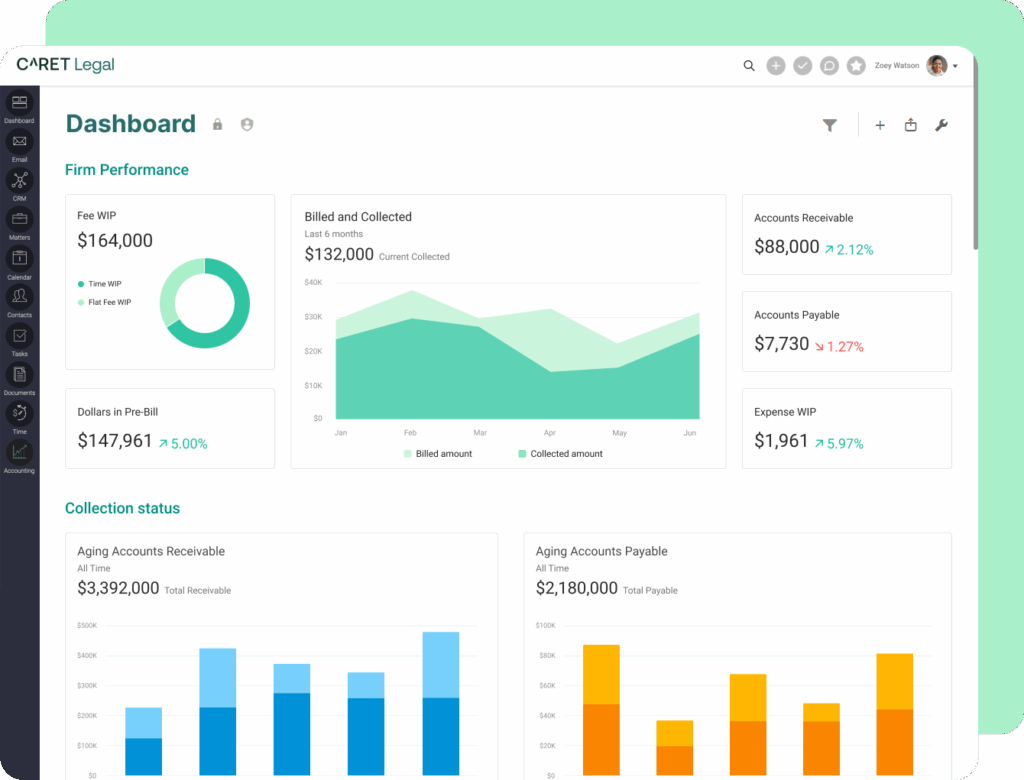The big takeaways:
- Tracking attorney-level metrics helps firms understand costs, collections, and revenue to improve profit margins.
- Profitability depends on more than hours billed; firms need consistent data on realization, collections, and costs.
- CARET Legal centralizes reporting so firms can spot trends and act before profitability slips.
Every law firm wants to improve profitability, but few have a clear view into how each attorney contributes to the firm’s financial performance. The solution starts with visibility. Firms that track individual attorney performance metrics alongside firm-wide data are better positioned to evaluate costs, allocate resources, and improve the law firm’s profit margin over time.
This approach moves beyond firm-wide revenue targets. By understanding profitability at the attorney level, law firms can better manage workloads, price matters more effectively, and identify performance patterns that support financial planning. Profitability becomes measurable when the right systems and metrics are in place.
Productivity vs. Profitability
Attorney productivity is often measured in billable hours. While useful, billable time only tells part of the story. An attorney can meet time targets while still generating low profitability. This disconnect often comes from uncollected invoices, discounted rates, or high overhead costs associated with specific practice areas or clients.
Profitability includes the relationship between hours billed, collections received, and costs incurred. By examining attorney performance metrics through this lens, firms gain a more accurate view of their law firm profit margin and the levers that influence it.
What to Track and Why It Matters
To improve law firm profitability, it is important to focus on measurable data points that reflect both financial health and operational efficiency. These include:
- Realization rate: how much of the billed time is actually invoiced
- Collection rate: how much of the invoiced amount is collected
- Profit per attorney: revenue generated minus allocated costs
- Overhead per attorney: a breakdown of administrative and fixed costs
- Client-level profitability: total cost versus revenue across engagements
Tracking these law firm profitability metrics consistently gives leadership the ability to monitor trends, spot problem areas early, and make adjustments to matter pricing or resource allocation.

From Data to Strategy
With reliable data in hand, law firm leaders can use attorney performance metrics to guide strategic conversations. This might include performance reviews, mentoring plans, or decisions around matter staffing and attorney development.
Metrics also support transparency. When attorneys understand how their work impacts the firm’s profit margin, it becomes easier to align performance expectations across teams. Associates gain clarity into their financial contributions, and partners have the tools they need to lead more effective teams.
Firms that use profitability metrics as part of their regular reporting process avoid surprises and improve financial forecasting. Small improvements in realization, collections, or staffing efficiency can produce meaningful gains across the year.
Building Profitability into Your System
Improving profitability is not just a matter of working longer hours. It requires systems that support accurate reporting, timely billing, and better visibility into firm-wide operations.
Legal practice management platforms, like CARET Legal, help firms organize their data and reduce the number of disconnected tools used to run the business. Billing, timekeeping, collections, and reporting are tied to a single matter and stored in one centralized system.
This allows law firm performance metrics to be monitored in real time, not just at year-end. Reports can be broken down by attorney, matter, client, or practice area, giving firm leaders the ability to make adjustments before issues affect the bottom line.
Time entries are easier to track, billing becomes more consistent, and collections can be reviewed in the context of overall profitability. These tools help eliminate manual reporting and give law firms the financial clarity they need to improve profit margins.
A Focused Approach to Long-Term Profitability
Improving law firm profitability may not require large-scale restructuring. Small, measurable improvements in how performance is tracked and reported can produce noticeable results. The most effective firms are the ones that understand where their revenue is coming from, how much of it is collected, and what it costs to deliver services.
Attorney-level reporting connects daily work to long-term goals. When firms build this visibility into their systems, profitability becomes part of the way they operate, not just a financial outcome reviewed at the end of the quarter.
Start by reviewing which attorney performance metrics your firm is currently tracking. Consider how this data is collected, how often it’s reviewed, and who has access to it. With a focused approach and the right tools, firms can improve financial performance one attorney at a time.
Start a free trial of CARET Legal today and learn how better reporting and visibility can support your firm’s profitability goals.
